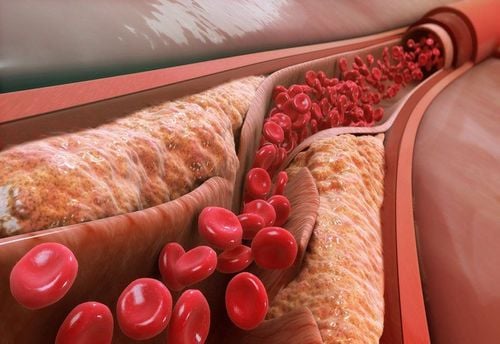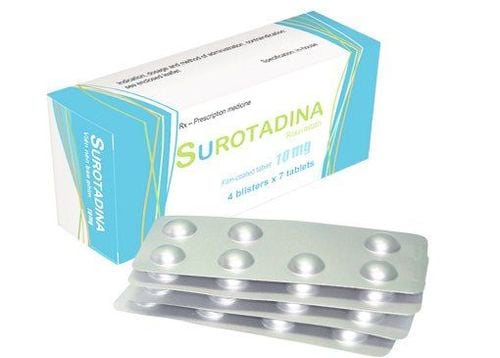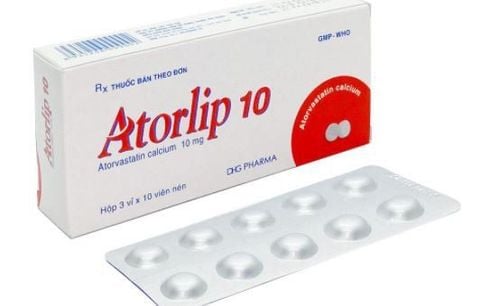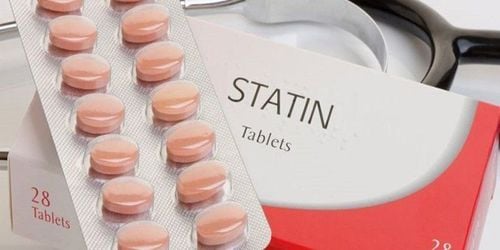This is an automatically translated article.
Ravastel 10mg is indicated for the treatment of primary hypercholesterolemia or mixed dyslipidemia (type llB) and homozygous familial hypercholesterolemia.1. What is Ravastel 10?
Ravastel 10 is a drug made in the form of tablets with the main ingredient Rosuvastatin 10mg.
Pharmacodynamic properties:
Rosuvastatin is a selective and competitive inhibitor of HMG-CoA reductase, which catalyzes the conversion of 3-hydroxy-3-methylglutaryl coenzyme A to mevalonate. The main site of action of the active ingredient Rosuvastatin is the liver, thereby lowering cholesterol.
Pharmacokinetics:
Absorption: Rosuvastatin is not completely absorbed from the gastrointestinal tract. The absolute bioavailability is about 20%. Peak plasma concentrations are reached approximately 5 hours after the patient has taken the drug. Distribution: Rosuvastatin is widely distributed in the liver, which is the major site of cholesterol synthesis and clearance of LDL-C. The volume of distribution of the active substance Rosuvastatin is approximately 134 L. Metabolism: Rosuvastatin is metabolised primarily by the cytochrome P450 isoenzyme CYP2C9. The plasma half-life is approximately 19 hours. The half-life did not increase with higher doses in the patient. Elimination: Approximately 90% of the dose of Rosuvastatin is eliminated unchanged in the faeces, the remainder is excreted in the urine.
2. Uses of the drug Ravastel 10
Uses of Ravastel 10 in the treatment of hypercholesterolemia:
Ravastel 10 is a dietary supplement in adults and children 6 years of age and older with mixed lipid disorders (type IIb), primary hypercholesterolemia (type IIa includes heterozygous familial hypercholesterolemia) or when diet and other measures such as exercise do not respond. As an adjunct to diet as well as other lipid-lowering measures in patients with homozygous familial hypercholesterolemia or when these measures are not appropriate. Use of Ravastel 10 for cardiovascular event prevention: Rosuvastatin is indicated as an aid in the prevention of primary cardiovascular events in high-risk patients.
3. Dosage and how to use Ravastel 10
Take Ravastel 10 by mouth at a dose depending on the therapeutic purpose as follows:
Treatment of patients with hypercholesterolemia:
The recommended starting dose is 5 mg or 10 mg once daily, increased to dose of 20 mg x 1 time / day after 4 weeks if absolutely necessary. The selection of the starting dose should take into account the patient's cholesterol level, future cardiovascular risk, as well as the potential for undesirable effects. Medical supervision is required when initiating a 40 mg dose in a patient. Prevention of cardiovascular events:
The usual dose is 20 mg of Ravastel per day. Children 6 - 17 years:
In children with heterozygous familial hypercholesterolemia, the usual starting dose of Ravastel 10 is 5 mg/day. In children 6-9 years of age with heterozygous familial hypercholesterolemia, the usual dose is 5 to 10 mg/day. For children 10-17 years of age with heterozygous familial hypercholesterolemia, the usual dose of Ravastel is 5-20 mg/day. In the pediatric population, the dose should be adjusted according to individual response and tolerability. Children should be placed on a low cholesterol diet before starting treatment with Ravastel. This diet should also be followed during treatment with Ravastel.
4 Contraindications to the use of Ravastel 10 mg
The following subjects are not allowed to use Ravastel:
Hypersensitivity to the ingredients of Ravastel; Patients with developed liver disease, including unexplained persistent elevations in serum transaminases and when transaminases are elevated more than 3 times the upper limit of normal; Patients with severe renal failure; Myopathy; Are taking Cyclosporin; Pregnant or nursing women should not use Ravastel.
5. Notes when using Ravastel 10 mg
When using the drug in patients with a history of liver disease, caution should be exercised in those with predisposing factors for rhabdomyolysis such as renal failure, hypothyroidism, personal or family history of hereditary muscle disease, addicts alcohol or over 70 years of age, conditions that cause increased blood levels of the drug and are taking with Fibratem concurrently. Discontinue use if CK levels > 5 x ULN or muscle symptoms become severe. Ravastel should not be used in the presence of sepsis, hypotension, major surgery, trauma, electrolyte and hormonal disturbances, or uncontrolled convulsions. Use caution when using Ravastel medicine for drivers and operators.
6. Drug interactions
Increases the risk of muscle damage when Ravastel is used concurrently with the following drugs:
Gemfibrozil and fibrates; Niacin at high doses (> 1 g/day); Drugs Colchicine ; Medicines for hepatitis C and HIV can increase the risk of muscle damage, most seriously rhabdomyolysis, kidney failure leading to kidney failure and even death. Therefore, when used with drugs to treat HIV, hepatitis C, it is necessary to limit the dose of Ravastel to a maximum of 10 mg once a day; Cyclosporin: Concomitant use of Ravastel with cyclosporin may increase the blood concentration of Rosuvastatin, so Ravastel should be used at a dose of 5 mg/day; Vitamin K antagonists, Gemfibrozil; Antacids: Concomitant administration of Ravastel with a suspension of antacids containing aluminum and magnesium hydroxide reduces plasma concentrations of Ravastel by approximately 50%; Erythromycin: Concomitant administration of Ravastel 10 mg with Erythromycin may reduce the AUC and Cmax of Ravastel by 20% and 30%. This interaction may be due to Erythromycin increasing intestinal motility; Oral contraceptives or hormone replacement therapy (HRT); Other Drugs: Data from specific drug interaction studies indicate no clinically significant interactions when Ravastel is co-administered with digoxin or fenofibrate.
7. Ravastel side effects
When using Ravastel 10 mg, patients may experience some of the following side effects:
Immune system disorders: Hypersensitivity reactions (including angioedema); Nervous system side effects: Headache, dizziness; Digestive system disorders: Common symptoms such as constipation, nausea, abdominal pain; Skin and Subcutaneous Tissue Disorders: Pruritus, rash and urticaria; Musculoskeletal, connective tissue and bone disorders such as myalgia. More rarely, myopathy, rhabdomyolysis; General disorders such as myasthenia gravis. In addition, users of the drug may experience other undesirable effects such as:
Cognitive decline such as memory loss and confusion; Increased blood sugar in the blood; Increased HbA1c levels. Inform your doctor of other undesirable side effects when you encounter them during the use of the drug.
Above is information about uses, dosage and usage of Ravastel 10 mg. Patients should carefully read the instructions for use, consult a doctor / pharmacist before use.
Please dial HOTLINE for more information or register for an appointment HERE. Download MyVinmec app to make appointments faster and to manage your bookings easily.













